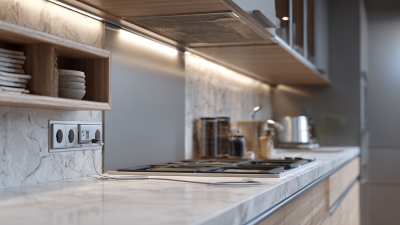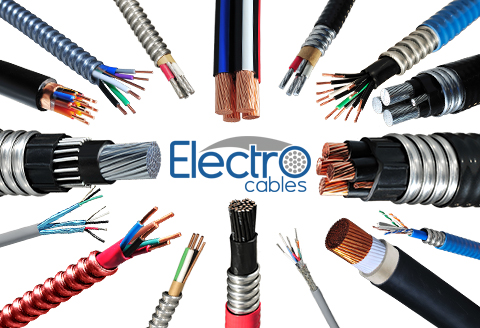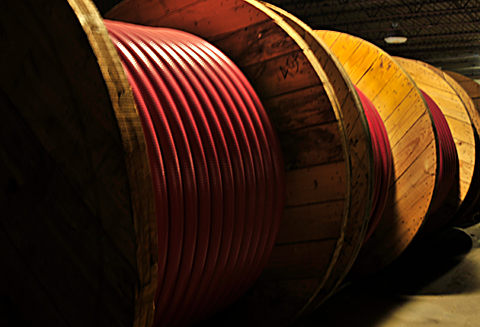A partner you can trust
10 Essential Tips for Choosing the Right Cooker Cable for Your Kitchen
When it comes to outfitting your kitchen, one of the most crucial yet often overlooked components is the cooker cable. As the primary connection between your cooking appliance and the electrical supply, choosing the right cooker cable ensures not only the performance of your equipment but also the safety of your culinary endeavors. According to the International Electrotechnical Commission (IEC), improper cabling can lead to electrical hazards, with reports showing that around 25% of kitchen fires are attributed to faulty wiring and appliances.
Industry expert Dr. Emily Hart, a leading electrical safety consultant, emphasizes, "Selecting the right cooker cable is essential for both efficiency and safety in the kitchen. It’s not just about connectivity; it’s about ensuring your cooking experience is both enjoyable and hazard-free." Understanding key parameters such as current ratings, cable insulation, and installation practices is vital. As technology evolves and kitchen appliances become more advanced, so too must our approach to their electrical connections. This guide will provide you with 10 essential tips to help navigate the complexities of choosing the right cooker cable for your kitchen.

Understanding Your Cooker’s Power Requirements
When selecting the right cooker cable for your kitchen, understanding your cooker's power requirements is crucial. Most electric cookers have power ratings that range between 1.5 kW to 15 kW, depending on their size and functionality. According to the Electrical Safety First organization, it's essential to match the cooker cable's current rating with the appliance’s power demand to ensure safety and efficiency. For instance, a cooker that operates at 7 kW will typically require a 32A cable to adequately carry the load without overheating.

Moreover, the cable length and type also play significant roles in performance. The Institute of Engineering and Technology indicates that longer cable runs can lead to voltage drop, impacting the appliance's efficiency. It's recommended that installers use a cable that is appropriately rated not just for the appliance's wattage, but also for any additional load that may be introduced in the kitchen, considering factors like induction hobs or multiple cooking zones. Remember, the choice of cable should also comply with the latest wiring regulations, ensuring that your kitchen remains both functional and safe.
Evaluating Different Types of Cooker Cables Available
When evaluating different types of cooker cables available for your kitchen, the first step is understanding the specific requirements of your cooker. Cooker cables come in various ratings, typically measured in amperes, which determine the amount of current they can safely carry. Common specifications include 13A for standard cookers and higher ratings for more powerful models. Therefore, it is crucial to check your appliance's manual or label to select the appropriate cable type that aligns with its power consumption.
Another key aspect to consider is the cable's construction and insulation material. Most cooker cables are made from either copper or aluminum, with copper being the preferred choice due to its superior conductivity and longevity. Additionally, the thickness of the cable, denoted by its gauge, affects how much power it can efficiently handle without overheating. Ensuring that you opt for a heat-resistant and durable insulation type, such as PVC or thermoplastic elastomer, is also essential. This will not only enhance safety but also provide greater flexibility during installation.

Assessing Cable Lengths for Optimal Kitchen Setup
When designing an optimal kitchen setup, assessing cable lengths for cooker cables is paramount to both safety and functionality. According to the National Electrical Code (NEC), the distance between the power point and the cooker should be carefully calculated to prevent electrical hazards and ensure efficient operation. A general guideline suggests that a cable length of approximately 2-3 meters is adequate for most kitchen layouts, providing enough room for maneuvering while minimizing excess slack that could lead to tripping hazards.
Furthermore, industry studies indicate that improper cable lengths can result in voltage drops, potentially affecting the performance of electrical appliances. A report from the Electrical Engineering Association highlights that for every additional meter of cable beyond the recommended length, there can be a voltage drop of approximately 2%, which can significantly impact your cooker's efficiency. Therefore, considering factors such as the position of outlets, the layout of your kitchen, and the specific requirements of your cooking appliances is critical. Properly assessing these elements not only enhances the kitchen's operational capacity but also ensures compliance with electrical safety standards.
Ensuring Compliance with Electrical Regulations
When selecting the right cooker cable for your kitchen, compliance with electrical regulations is a paramount consideration. These regulations are in place to ensure safety and efficiency, preventing potential hazards that could arise from improper installations. It's essential to familiarize yourself with the National Electrical Code (NEC) or your local regulatory guidelines, which set forth the requirements for wire gauge, amperage, and insulation types that must be adhered to when installing cooker cables.
Choosing a cable that meets these standards not only enhances safety but also optimizes performance. For instance, using a cable with the appropriate current rating will prevent overheating, reducing the risk of electrical fires.
Additionally, ensure that the cable is suitable for the type of installation—whether it is run through walls, exposed, or in damp environments. By prioritizing compliance with electrical regulations, you can make informed decisions that safeguard both your home and your cooking appliances.
Choosing the Right Amp Rating for Safety and Efficiency
When selecting a cooker cable for your kitchen, the amp rating is a crucial factor to ensure both safety and efficiency. The amp rating of a cable determines the amount of electrical current it can safely handle without overheating. For electrical cookers, common amp ratings range from 13A to 32A, with the specific rating depending on the power requirements of your appliance. It’s essential to match the cable’s amp rating with the cooker’s specifications; using an undersized cable can lead to overheating, posing a fire risk, while an oversized cable may not function efficiently.
In addition to the amp rating, consider the cable’s material and insulation quality. Copper cables are preferred for their excellent conductivity and durability. Ensure that the cable insulation can withstand high temperatures, especially if it runs close to heat sources. Always consult the local electrical regulations and guidelines, or better yet, seek the advice of a qualified electrician. This will not only safeguard your kitchen’s electrical system but also enhance the performance of your cooking appliances, allowing for a hassle-free culinary experience.
10 Essential Tips for Choosing the Right Cooker Cable for Your Kitchen
| Tip Number | Tip Description | Recommended Amp Rating | Suitable Cable Type |
|---|---|---|---|
| 1 | Assess your cooker wattage | 32A | H05RR-F |
| 2 | Consider the length of the cable | 16A | H07RN-F |
| 3 | Check for existing wiring conditions | 20A | H03VV-F |
| 4 | Ensure compatibility with the plug type | 13A | H05VVH2-F |
| 5 | Follow local electrical codes | 32A | H07V-R |
| 6 | Prioritize durable and heat-resistant materials | 16A | H07B-F |
| 7 | Evaluate your kitchen layout for cable routing | 20A | FRLSZ Cable |
| 8 | Use insulated connections | 32A | H05Z1Z2-K |
| 9 | Consult with a certified electrician | 10A | H02S |
| 10 | Regularly check the cable for wear and tear | 16A | H05SS |
Related Posts
-

Exploring Cooker Cable Innovations at the 2025 China Import and Export Fair
-

Understanding the Importance of Cooker Cable in Modern Kitchen Appliances
-

How to Choose the Right Wire and Cable for Your Electrical Projects
-

Essential Guide to Choosing the Right Cable Conduit for Your Electrical Projects
-

Exploring Innovative Power Extension Cable Options for Every Need
-

Comprehensive Guide to Selecting the Best Flexible Cable Conduit for Your Project

Products
Products
LEARN MORE
Current Inventory
Current Inventory
LEARN MORE
Custom Solutions
Custom Solutions
WE CAN HELPLighting Power & Control-Signal Cable
This content is restricted to site members. If you are an existing user, please log in. New users may register … LEARN MORE “Lighting Power & Control-Signal Cable”
LOOKING
FOR HELP?
We are here to help. You can contact us or create an account online to have access to special products, technical specifications and our new online quote tool.
ELECTRO CABLES
9 Riverside Drive
P.O. Box 276
Trenton, Ontario
CANADA K8V 5R5
N.A. Toll Free: 888-ELECTRO
(1-888-353-2876)
World: 613-394-4896
Fax: 613-394-4101
Email: sale@machinecables.com
We manufacture cables that are certified by the Canadian Standards Association (CSA), listed by Underwriters Laboratories and/or listed by Intertek (ETL).
Our quality management system is registered to ISO 9001: 2015. Our team is dedicated to consistently providing quality service and products to our customers.

© 2025 ELECTRO CABLES • SITE BY SNAP 360•
